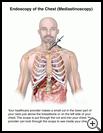
Endoscopy of the Chest
________________________________________________________________________
KEY POINTS
- Endoscopy of the chest is a procedure that uses a slim, lighted tube to look inside your upper chest to help your healthcare provider diagnose infections and some types of cancer.
- Tell your healthcare provider about all medicines and supplements that you take. Ask your healthcare provider if you need to avoid taking any medicine or supplements before the procedure.
- Ask your healthcare provider how and when you will get your test results, how to take care of yourself at home, and when you can return to your normal activities.
________________________________________________________________________
What is endoscopy of the chest?
Endoscopy of the chest is a procedure that uses a slim, lighted tube (called a mediastinoscope) to look inside your upper chest.
This procedure is also called mediastinoscopy.
When is it used?
This procedure is used to look at the area behind your breastbone and between your lungs. Mediastinoscopy can help diagnose:
- Infections
- Lung cancer
- Lymph node cancer (normal lymph nodes store white blood cells and filter blood to fight infection)
- Metastatic cancer
- Thymus gland cancer (the thymus gland is part of your immune system)
- Sarcoidosis (a condition that causes swelling and irritation of the tissues around your organs, such as the lungs, liver, and spleen)
The results of this procedure may also help your healthcare provider choose the best treatment.
Ask your healthcare provider to explain why you are having the procedure and any risks.
How do I prepare for this procedure?
- Make plans for your care and recovery after you have the procedure. Find someone to give you a ride home after the procedure. Allow for time to rest and try to find other people to help with your day-to-day tasks while you recover.
- Follow your provider's instructions about not smoking before and after the procedure. Smokers may have more breathing problems during the procedure and heal more slowly. It is best to quit 6 to 8 weeks before surgery.
- You may or may not need to take your regular medicines the day of the procedure. Tell your healthcare provider about all medicines and supplements that you take. Some products may increase your risk of side effects. Ask your healthcare provider if you need to avoid taking any medicine or supplements before the procedure.
- Tell your healthcare provider if you have any food, medicine, or other allergies such as latex.
- Your healthcare provider will tell you when to stop eating and drinking before the procedure. This helps to keep you from vomiting during the procedure.
- Follow any other instructions your healthcare provider gives you.
- Ask any questions you have before the procedure. You should understand what your healthcare provider is going to do. You have the right to make decisions about your healthcare and to give permission for any tests or procedures.
What happens during the procedure?
You will be given a general anesthetic before the procedure. General anesthesia relaxes your muscles and puts you into a deep sleep.
Your healthcare provider will make a small cut in the lower part of your neck just above the breastbone. Your provider will put the scope through the cut and into your chest. Your provider can look through the scope to see inside your chest. Your provider may remove some tissue for tests, which is called a biopsy. Then the scope will be removed and the cut will be closed with stitches.
What happens after the procedure?
You may be able to go home after the procedure, or you may need to stay in the hospital for a day or two.
Ask your healthcare provider:
- How and when you will get your test results
- How long it will take to recover
- If there are activities you should avoid and when you can return to your normal activities
- How to take care of yourself at home
- What symptoms or problems you should watch for and what to do if you have them
Make sure you know when you should come back for a checkup. Keep all appointments for provider visits or tests.
What are the risks of this procedure?
Every procedure or treatment has risks. Some possible risks of this procedure include:
- You may have problems with anesthesia.
- The veins or arteries in the area could be damaged. If the veins or arteries are damaged, you may need surgery to open the chest through the breastbone to control the bleeding.
- Your lung could collapse. If this happens, you may need a flexible tube inserted between your ribs into your chest to help inflate the lung.
- The nerves in your neck may be injured, causing weakness in your voice box, speech function, or tongue muscles.
- You may have infection or bleeding.
Ask your healthcare provider how these risks apply to you. Be sure to discuss any other questions or concerns that you may have.

